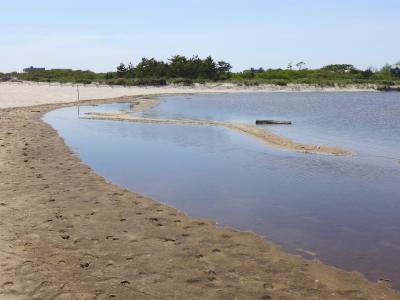Georgica Pond Opened for Shellfishing

Four weeks after they ordered Georgica Pond closed to the harvesting of crabs and other marine life due to a report a toxic blue-green algae from Suffolk officials, the East Hampton Town Trustees reopened the pond as the algal bloom had significantly diminished.
"The bacteria levels have been down for about two weeks now," Bill Taylor, a deputy clerk of the trustees, said last week of the bloom of cyanobacteria, or blue-green algae. Mr. Taylor removed the signs that had been posted to notify the public that crabbing was prohibited around July 7, he said.
Real-time data transmitted by a telemetry buoy in the pond indicated a cyanobacteria level of 0.6 micrograms per liter on Monday morning. That level had surpassed 3 micrograms per liter early last month, prompting the prohibition on crabbing and the taking of other marine life.
Cyanobacteria, or blue-green algae, can cause nausea, vomiting, diarrhea, skin and eye irritation, allergic reactions, and breathing problems. The Suffolk County Department of Health Services has advised the public not to swim or wade in contaminated waters and to keep pets and children away until warnings are lifted. In the case of accidental contact, the county advises that people rinse themselves off with clean water immediately and seek medical attention if symptoms arise.
Christopher Gobler of Stony Brook University's School of Marine and Atmospheric Sciences has been monitoring the pond's water quality for the trustees for several years. More recently, the Friends of Georgica Pond Foundation, a group of pondfront property owners that is working to restore it to health, also retained his services.
"Historically, blue-green algae blooms tend to show a bimodal summer distribution, peaking in late spring and again in later summer into fall," Dr. Gobler wrote in an email to The Star on Thursday. "In 2014 and 2015, blooms occurred in August and September. So, while the overall conditions are basically ripe for a bloom, the absence of one right now is actually consistent with prior years (excluding 2016) and other locations on the South Fork."
Last year, the Friends of Georgica Pond Foundation leased an aquatic weed harvester to remove macroalgae from the pond. As it decays, the macroalgae provides nutrients to harmful algae such as cyanobacteria. The removal last summer of more than 55,000 pounds of macroalgae is believed to be responsible for a substantial reduction in the levels of cyanobacteria recorded last year, and may be a factor in the relatively brief bloom that occurred last month.
"It's too early to pin it down on one thing," Mr. Taylor said of the diminishing bloom. "We're trying to get years of data to put the pieces together."
